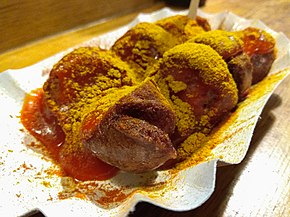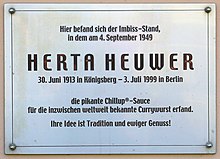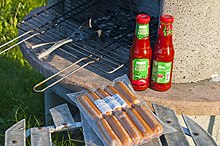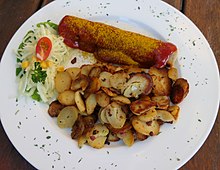Currywurst
![]()
This article describes the snack dish. For the song of the same name by Herbert Grönemeyer see Currywurst (song), for the fast food restaurant in Herne see Die Currywurst.
Currywurst [ˈkʰœ ʀiˌvʊʁst] ( ![]() ) is a dish of fried or other boiled sausage served whole or sliced with a tomato-based sauce and curry powder or with a curry ketchup. It is classified as part of German cuisine. The sausages are usually fine, pre-cooked boiled sausages with or without intestines. Served since the post-war period, the dish is known mainly in the snack gastronomy. It is also a popular offering in German company canteens and is also available as a ready-made meal for private households.
) is a dish of fried or other boiled sausage served whole or sliced with a tomato-based sauce and curry powder or with a curry ketchup. It is classified as part of German cuisine. The sausages are usually fine, pre-cooked boiled sausages with or without intestines. Served since the post-war period, the dish is known mainly in the snack gastronomy. It is also a popular offering in German company canteens and is also available as a ready-made meal for private households.
In Germany, over 800 million curry sausages are consumed every year. Independent of this, sausages in which curry powder is included as an additive in the sausage meat are also referred to as curry sausages.
Currywurst (in combination with French fries) is the most popular canteen food in Germany for the 28th year in a row in 2020, but was replaced by spaghetti Bolognese in 2021.

Currywurst in cardboard bowl
History
According to widespread belief, the currywurst originated in Berlin in the period after the Second World War. The restaurateur Herta Heuwer, who had been running a snack bar on the corner of Kant-/Kaiser-Friedrich-Strasse in Berlin's Charlottenburg district since the summer of 1949, claimed to have invented the typical currywurst sauce in September 1949, served it with the fried sausage and thus invented the currywurst. It later provided its business with addresses such as: "1st currywurst roastery in the world" and "A Berlin speciality invented by us" and in 1959 registered the word-picture trademark "Chillup" for its sauce - a contraction of chilli and ketchup, recorded on 21 January 1959 on application of 21 February 1958 under number 721319 as a trademark for "Spezial-Sosse"[sic!] in the Zeichenrolle of the German Patent Office - Heuwer incorrectly described this as a "patent". According to Heuwer's account, the Kraft company (→ Mondelēz) unsuccessfully sought the recipe and the trademark right from her. Throughout her life, Heuwer insisted that she had used neither ketchup nor a ready-made seasoning mix, but had mixed the sauce with tomato paste and carefully seasoned it with individual spices. In her old age, she made several television appearances and was celebrated as the "inventor of the currywurst". The German Currywurst Museum, which opened in Berlin in 2009 and will remain open until December 2018, followed this view. Since 29 June 2003, there has been a commemorative plaque in honour of Herta Heuwer at the former location of her snack bar (→ Kantstraße 101; today an Asian supermarket).
However, Heuwer cannot claim the development of the currywurst entirely on its own. For one thing, certain details of her account do not seem plausible. She was keen to recall that on 4 September 1949, when she first stirred her sauce, it was raining profusely, whereas according to weather records it was supposed to have been a dry day. On the other hand, the role of the butcher Max Brückner from Johanngeorgenstadt in the Erzgebirge is to be considered above all. He had come to West Berlin after the end of the war, founded a company in Berlin-Spandau with a few employees from his homeland and had a self-developed process for the production of sausage without casing, which became known as "Spandauer ohne Pelle". In the early 1950s, he joined forces with Frank Friedrich, who also came from the Ore Mountains. The company they built, Maximilian, still exists. Older versions of the website contained detailed accounts of the company's history and its collaboration with Herta Heuwer. According to this, Heuwer's "first sauce creations" in 1949 did not yet lead to great success. It was only together with Frank Friedrich that she developed the final recipe, which she sold in her snack bar from then on. However, this account emphasizes that the currywurst as a dish was Heuwer's invention, because the idea to add the sauce was hers.
"Did Herta Heuwer invent the currywurst? There is no doubt today that she did. The connection gutless 'Spandauer without pellet' and her idea to combine this with her own seasoning sauce, a ketchup is clearly her idea. For the taste success, on the other hand, in coordination with Herta Heuwer, Frank Friedrich, today's senior and then junior partner of the company founder Max Brückner, is responsible for the final taste coordination of the sausage and the sauce."
The success of Brückner's sausage without casing/pellet was due to the emergency situation in the post-war period. Natural casings were in short supply after the Second World War. To make sausage, the sausage meat (meat/fat mass) is pressed into a casing where it matures. This is how the sausage gets its shape. With Brückner's production method the sausage got its shape without casing. The first customer was the Jankowitz family from Spandau. The "Spandauer without pellet" was well received together with the popular tomato sauce (after Herta Heuwer's model). Later, when other snack vendors sold this sausage, the name "curry sausage without intestine" prevailed.

Memorial plaque for Herta Heuwer in Berlin

Currywurst with french fries
Variants
Currywurst is prepared differently from region to region. Sometimes the sauce is heated, sometimes seasoned with curry powder. The consistency ranges from pasty to thin, in some areas or individual snack bars it is plain ketchup.
Berlin currywurst
There are two basic varieties of Berlin curry sausage: with or without casing. The sausages without casings are cylindrical and whitish in colour, comparable to Bavarian woollen sausages. Requirements for the quality of Berliner Currywurst were agreed as early as 1951 between the Berlin authorities and the butchers' guild; this resulted in a so-called Berliner Verkehrsauffassung, which was later laid down by the competent Land authority and published in the Allgemeine Fleischer-Zeitung on 20 August 1967. According to this opinion, which was recognised in Berlin decades later, a fine, non-cured and non-smoked sausage of medium quality with a maximum addition of extraneous water of five per cent must be used as a sausage. Simple qualities or other sausages may therefore not be offered as 'Currywurst', but for example as 'Bratwurst mit Curry' or 'Dampfwurst mit Curry'.
Both varieties are first fried whole, usually in a fat pan about half covered with hot fat. When served, the sausage is cut by hand into bite-sized pieces - some traditional snack stands, such as Krasselt's Imbiß in Berlin-Steglitz, only serve currywurst with an angled cut. In this case, both halves of the sausage are fitted with a wooden piercer. Finally, the sausage is doused with the sauce and sprinkled liberally with curry powder (or vice versa). If desired, cayenne pepper (order: "hot" or "extra hot") or crushed dried chili peppers (order: "with seeds") are added. The addition of Worcester sauce or "hot onions" (chopped raw onions with chili) may be desired. A special ketchup based on tomato paste and spices is often made by the stand and is often added warm over the sausage links.
In the 1960s, the currywurst became known in East Berlin - among others through Konnopke's Imbiß. In GDR times, only curry sausage without casing was offered; bratwursts had already been produced without casing before. The sausage was served uncut in one piece with curry powder and cold thin ketchup (or cold thick tomato sauce). For eating with the fingers, one end of the sausage was left without sauce.
The typical side dish is a small soft roll, which is particularly good for dipping the sauce. In East Berlin it was a normal Schrippe or a slice of untoasted toast. Other typical side dishes are French fries, often with mayonnaise, or fried potatoes.
On 6 March 2020, the "Berlin Currywurst without intestine" was registered by the German Patent and Trademark Office as Geographical Indication 31 2017 001 169.4. This means that this type of "Berliner Currywurst" may only be produced in Berlin. The testing procedure took thirteen years, as many other producers also wanted to produce from outside.
Volkswagen Currywurst
→ Main article: Volkswagen Currywurst
The currywurst from the Volkswagen canteens in Wolfsburg is well known beyond the factory boundaries. The Currybockwurst has been available for consumption since 1973. In 2014, the VW butchery produced 6.3 million pieces. The sausage has around 20 percent fat content and contains neither phosphates nor milk protein. In this sausage, the sausage meat itself is seasoned with curry. This is added to the meat with pepper before it is smoked and cooked. VW curry sausage and VW spiced ketchup are also available in supermarkets in parts of Lower Saxony.

Volkswagen curry sausage and curry ketchup

Berlin Currywurst, S-Bahn at Berlin-Tegel Airport

Konnopke's Imbiß in Schönhauser Allee in Berlin

Currywurst with fried potatoes
Questions and Answers
Q: What is currywurst?
A: Currywurst is a German dish made from sliced pork sausage covered in a curry sauce, usually made with ketchup or tomato paste blended with curry powder.
Q: Where can you find currywurst?
A: Currywurst is often sold as a take-out food, at diners or "greasy spoons," on children's menus in restaurants, or as a street food.
Q: Who invented the currywurst sauce?
A: There are two stories about the invention of the currywurst sauce. One legend says that Herta Heuwer from Königsberg invented it in her stall in Berlin-Charlottenburg in 1949. People from the Ruhr-area say that the sauce was accidentally invented by a sausage stall owner in Essen, who dropped a can with curry powder into some ketchup.
Q: What type of powder is used in the curry sauce?
A: Curry powder is used in the sauce to give it its distinctive flavor.
Q: Is currywurst only found in Berlin?
A: Although Berlin claims currywurst as its invention and "national dish," it can be found all over Germany, and there are more than 20 different types of currywurst.
Q: How is currywurst typically served?
A: Currywurst is typically served sliced, with the curry sauce and generous amounts of curry powder added to it.
Q: Who wrote a song about currywurst?
A: Early in his career, German pop singer Herbert Grönemeyer, raised in Bochum, wrote a song, in the Ruhr dialect, to currywurst.
Search within the encyclopedia